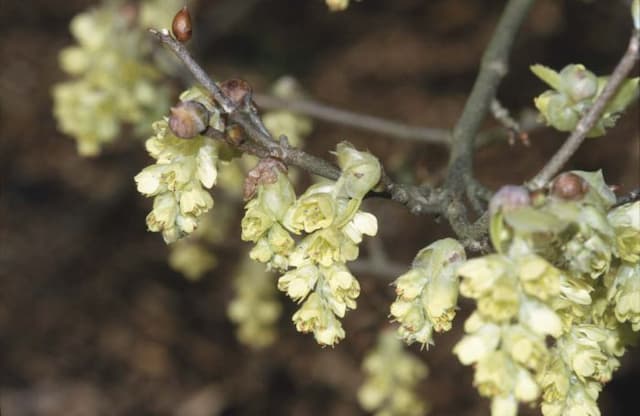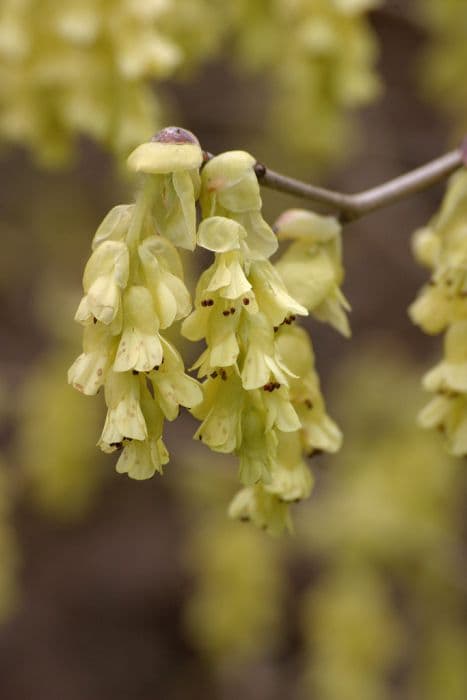Persian Ironwood Parrotia persica 'Vanessa'

ABOUT
The Parrotia persica 'Vanessa', commonly known as the Persian Ironwood 'Vanessa', is an ornamental tree known for its striking beauty throughout the seasons. It has a distinctively narrow, upright form, which makes it an ideal choice for those looking for a tree with a smaller footprint. The leaves of the Persian Ironwood 'Vanessa' are one of its most captivating features. They emerge in the spring as a fresh, green color and gradually change as the seasons progress. In the autumn, the foliage transforms into a magnificent display of colors ranging from bright yellow to deep burgundy and rich scarlet, rivalling even the most colorful of autumnal trees. The bark of Persian Ironwood 'Vanessa' is another notable characteristic, with a smooth texture that exfoliates in patches, revealing a mosaic of greys, greens, whites, and pinks. This provides excellent winter interest, as the tree exhibits a striking pattern on its trunk and branches when the leaves have fallen. 'Vanessa' also produces inconspicuous red and yellow flowers in late winter to early spring before the leaves appear. Although the flowers are small and may not be the main attraction, they offer a subtle beauty and early spring interest. These are followed by small, brown, non-ornamental fruit capsules that add a textural element in late summer and into fall. Overall, the Persian Ironwood 'Vanessa' is a versatile and aesthetically pleasing tree, with a graceful, upright shape and foliage that offers a variety of colors throughout the year, enhanced by its attractive exfoliating bark.
About this plant
 Names
NamesFamily
Hamamelidaceae
Synonyms
Persian Ironwood, Persian Parrotia, Ironwood
Common names
Parrotia persica 'Vanessa'.
 Toxicity
ToxicityTo humans
Persian Ironwood (Parrotia persica 'Vanessa') is generally not known to be toxic to humans. There are no common symptoms of poisoning associated with this plant because it is not considered poisonous. Therefore, ingesting parts of Persian Ironwood typically does not lead to any toxic consequences for humans.
To pets
Persian Ironwood (Parrotia persica 'Vanessa') is also not commonly known to be toxic to pets. It is not listed as a poisonous plant for animals, so ingestion of this plant by pets is unlikely to result in significant symptoms of poisoning or toxicity. However, it is always advisable to prevent pets from ingesting plants as a precautionary measure.
 Characteristics
CharacteristicsLife cycle
Perennials
Foliage type
Deciduous
Color of leaves
Varies
Height
20-35 feet (6-11 meters)
Spread
15-30 feet (4.5-9 meters)
Plant type
Tree
Hardiness zones
4-8
Native area
Iran
Benefits
 General Benefits
General Benefits- Year-round interest – The Persian Ironwood 'Vanessa' offers remarkable seasonal changes, from vivid fall foliage to attractive exfoliating bark in winter, making it a captivating choice throughout the year.
- Drought tolerance – Once established, it has a good tolerance to drought conditions, making it suitable for areas with water restrictions.
- Low maintenance – It requires minimal pruning and is not demanding regarding soil types, simplifying garden care.
- Pest resistance – This cultivar is relatively resistant to common pests, reducing the need for chemical treatments.
- Urban adaptability – It copes well with urban pollution and compacted soils, making it a robust choice for city landscapes.
- Wildlife attraction – The tree supports local wildlife by providing habitat and food sources such as nectar and seeds for birds and insects.
- Architectural form – With its upright, columnar growth habit, Persian Ironwood 'Vanessa' provides a strong vertical accent in landscape designs.
- Space efficient – The columnar form also means it takes up less horizontal space, suitable for smaller gardens or narrow spaces.
 Medical Properties
Medical PropertiesThis plant is not used for medical purposes.
 Air-purifying Qualities
Air-purifying QualitiesThis plant is not specifically known for air purifying qualities.
 Other Uses
Other Uses- Winter Interest: Parrotia persica 'Vanessa', commonly known as Persian Ironwood, offers striking winter interest with its exfoliating bark that reveals a mosaic of greens, tans, and grays.
- Bonsai: Due to its attractive foliage and branching pattern, Persian Ironwood can be cultivated as a bonsai, making it a unique addition to miniature garden landscapes.
- Wildlife Garden: The tree's flowers provide early-season nectar for pollinators while the dense branching can offer nesting sites for birds.
- Photography Backdrop: Persian Ironwood, with its vivid fall colors and textured bark, can serve as a photogenic backdrop for outdoor portrait photography.
- Urban Landscaping: Its resistance to pollution and compact growth habit make Persian Ironwood suitable for urban street or park trees.
- Educational Tool: This species can be used in educational settings to teach students about plant adaptations, as it exhibits tolerance to different soil types and urban conditions.
- Woodworking Projects: While not commercially common, the hard, durable wood of Persian Ironwood can be used in small woodworking projects, like crafting decorative items or turned bowls.
- Dye Source: The leaves and bark of Persian Ironwood may be used to produce natural dyes for textiles, though this is not a widely established use.
- Screen Planting: When planted in a row or as a hedge, Persian Ironwood can provide an attractive screen for privacy due to its dense foliage.
- Fall Celebrations: Branches bearing the tree's brilliant fall leaves can be incorporated into seasonal decorations and displays, particularly in autumn-themed events.
Interesting Facts
 Feng Shui
Feng ShuiThe Persian Ironwood is not used in Feng Shui practice.
 Zodiac Sign Compitability
Zodiac Sign CompitabilityThe Persian Ironwood is not used in astrology practice.
 Plant Symbolism
Plant Symbolism- Resilience: As the Persian ironwood 'Vanessa' is known for its ability to adapt and withstand difficult growing conditions, it often symbolizes resilience and the capacity to endure challenges.
- Longevity: Given the long lifespan of this plant, it is frequently associated with longevity and the passage of time.
- Exotic Beauty: With its unique, colorful flowers that resemble a parrot's plumage, it symbolizes exotic beauty and the allure of the uncommon.
- Transformation: As the Persian ironwood 'Vanessa' exhibits a striking change of colors through the seasons, it represents transformation and the nature of change in life.
 Water
WaterThe Persian Ironwood (Parrotia persica 'Vanessa') should be watered thoroughly, allowing the soil to become moderately dry between waterings. Initially, after planting, water the tree two to three times a week to help establish the root system, using approximately 1-2 gallons of water each time. Once established, reduce watering to once a week, adjusting for rainfall and temperature, ensuring it receives 1-2 gallons per week during dry periods. Over-watering or poorly drained soil can lead to root rot, so good drainage is essential. During winter months, when the tree is dormant, you may need to water less frequently.
 Light
LightPersian Ironwood prefers a location where it can receive full sun to partial shade. The ideal spot would be one where the plant gets at least four hours of direct sunlight each day, but it's also tolerant of light shade, especially during the hotter parts of the afternoon. Ensure the chosen location protects the tree from harsh winds, which could damage the foliage.
 Temperature
TemperaturePersian Ironwood is hardy and can endure a temperature range from about -20°F to 100°F. The ideal temperature for thriving growth would be between 60°F and 80°F. It is important to avoid planting in locations where cold winter winds could damage the tree or overly hot conditions that could stress the plant.
 Pruning
PruningPersian Ironwood benefits from pruning to maintain its desired shape and to remove any damaged or diseased branches. The best time to prune is late winter or early spring before new growth starts. Prune sparingly, as this species does not require heavy pruning; focus on shaping and removing only necessary branches. Typically, pruning once a year is adequate to preserve the health and aesthetics of the tree.
 Cleaning
CleaningAs needed
 Soil
SoilPersian Ironwood thrives in well-draining, fertile soil with a pH range of slightly acidic to neutral, typically between 5.5 to 7.5. A mix containing loam, peat, and coarse sand or perlite is ideal to ensure adequate drainage and fertility for optimal growth.
 Repotting
RepottingPersian Ironwood is a slow-growing tree that doesn't require frequent repotting. Repotting can be done every few years as the plant matures or when it is observed that the root system has outgrown its current container.
 Humidity & Misting
Humidity & MistingPersian Ironwood is adaptable to a range of humidity levels and typically does well in the average outdoor humidity of its growing regions. It does not require any special humidity adjustments when grown outdoors.
 Suitable locations
Suitable locationsIndoor
Place in bright indirect light, and ensure room is well-ventilated.
Outdoor
Plant in full sun to partial shade, shield from strong winds.
Hardiness zone
4-8 USDA
 Life cycle
Life cycleThe Persian Ironwood 'Vanessa' begins its life as a seed, which, under suitable conditions of warmth and moisture, germinates into a seedling. The seedling stage is characterized by the emergence of the first set of true leaves after the cotyledons (seed leaves). As the plant enters the juvenile phase, it focuses on vegetative growth, developing a strong root system and a woody stem that starts to branch. After several years, it reaches maturity and can initiate the reproductive phase, where it produces flowers—small, red inflorescences in late winter to early spring before the leaves appear. Following pollination, the flowers develop into small, nut-like fruits. Throughout its life, Persian Ironwood 'Vanessa' undergoes seasonal changes, shedding its leaves in the fall to reveal a striking exfoliating bark, and continues this cycle as a perennial plant until the end of its lifespan, which can extend for several decades under optimal conditions.
 Propogation
PropogationPropogation time
Early Spring
Parrotia persica 'Vanessa', commonly known as Persian Ironwood, is typically propagated by softwood cuttings. The best time to take these cuttings is in late spring to early summer when new growth is still supple. To propagate by this method, cut a 4 to 6-inch (about 10 to 15 cm) piece from the tip of a healthy branch, making sure it includes at least two sets of leaves. Remove the leaves from the bottom half of the cutting, dip the cut end in rooting hormone, and plant it in a well-draining potting mix. The cutting should be kept moist and in high humidity conditions by covering it with a plastic bag or placing it in a propagator. Roots typically develop in a few weeks, after which the new plant can be gradually acclimatized to less humid conditions and eventually planted out.









